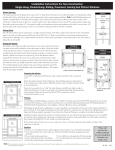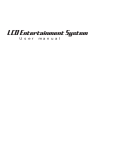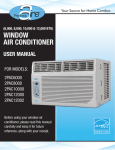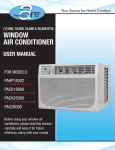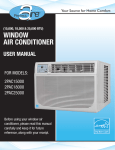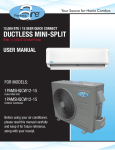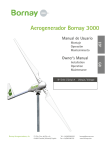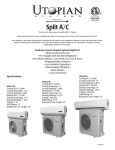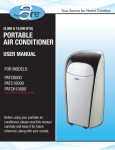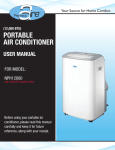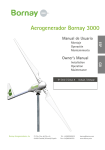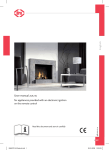Download CASEMENT/SLIDER AIR CONDITIONER
Transcript
Your Source for Home Comfort (10,000 & 12,000 BTU) CASEMENT/SLIDER AIR CONDITIONER USER MANUAL FOR MODELS: PASC10000 PASC12000 Before using your casement/slider air conditioner, please read this manual carefully and keep it for future reference, along with your receipt. CONTENTS SAFETY PRECAUTIONS ..................................................................................... 2 IMPORTANT SAFETY INSTRUCTIONS ...............................................................4 NORMAL SOUNDS .............................................................................................. 5 AIR CONDITIONER FEATURES..........................................................................6 INSTALLATION INSTRUCTIONS .......................................................................10 CARE AND CLEANING.......................................................................................18 TROUBLESHOOTING TIPS ............................................................................... 19 This manual provides the information needed for proper use and maintenance of this air conditioner. Basic preventative care can help extend the life of this unit. The “Troubleshooting Tips” section in this manual contains a chart with solutions to the most common problems. Referring to this section may save time and prevent the need for a service call in the event of a problem. ! CAUTION ●Contact an authorized service technician for repair or maintenance of this unit. ●Contact an installer for installation of this unit if necessary. ●The air conditioner is not intended for use by young children without supervision. Young children should be supervised to ensure that they do not play with the air conditioner. ●Disabled persons may require assistance with set up. ●If the power cord is to be replaced, replacement work should be performed by authorized personnel only. ●Installation and repair work must be performed in accordance with the national wiring standards by authorized personnel only. ●Do not operate your air conditioner in a wet room such as a bathroom or laundry room. ●Units with a heating function should be at least 3 1/3 ft (1 meter) away from any combustible/ flammable materials. NOTE: All the illustrations in this manual are for explanation purposes only. Unit purchased may be slightly different. The design and specifications are subject to change without prior notice for product improvement. Contact customer service for details. 1 SAFETY PRECAUTIONS To prevent injury to the user or other people and property damage, the following instructions must be followed. Incorrect operation due to ignoring of instructions may cause harm or damage. The seriousness is classified by the following indications. ! ! WARNING ! CAUTION This symbol indicates the possibility of death or serious injury. This symbol indicates the possibility of injury or damage to property. Meanings of symbols used in this manual are as shown below. ! ! Never do this. Always do this. ! ! ! Plug in power plug properly. Do not operate or stop the unit by inserting or pulling out the power plug directly from the wall. Failure to do so may cause electric shock or fire due to excess heat generation. Doing so may cause electric shock or fire due to heat generation. Do not modify power cord length or share the outlet with other appliances. Do not operate with wet hands or in damp environment. Do not direct airflow directly at room occupants. Always ensure effective grounding. Do not allow water to run into electric parts. ! grounding may cause electric shock. Doing so may cause failure of machine or electric shock. Incorrect installation may cause fire and electric shock. Always unplug the unit if strange sounds, smell or smoke comes from the unit. Do not use the socket if it is loose or damaged. ! Failure to do so may cause fire and electric shock. ! Doing so may cause fire. This could cause health issues. Always install circuit breaker and a dedicated power circuit. Do not open the unit during operation. Doing so may cause fire and electric shock. Doing so may cause electric shock. Do not use the power cord close to heating appliances. Do not disassemble, modify, or drill holes into the air conditioner. Doing so may cause failure and electric shock. Do not use firearms near unit. ! Doing so may cause electric shock or fire. If the power cord is damaged, it must be replaced by the manufacturer or an authorized service center or a similarly qualified person in order to avoid a hazard. Doing so may cause electric shock. ! Incorrect ! Do not use a damaged power cord. so may cause electric shock or fire due to heat generation. ! Doing ! ! WARNING Doing so may cause fire and electric shock. Ventilate room before operating air conditioner if there is a gas leakage from another appliance such as a stove. Do not use the power cord near flammable gas or combustibles, such as gasoline, benzene, thinner, etc. Failure to do so may cause explosion, fire and burns. Doing so may cause an explosion or fire. 2 ! CAUTION ! ! When removing air filter, do not touch metal parts of the unit. Do not clean with water. Doing so may cause an injury. . Water may enter the unit and degrade the insulation causing an electric shock. Unit and Circuit breaker/fuse must be switched OFF when cleaning. Do not put a pet or house plant where it will be exposed to direct air flow. Cleaning unit when power is ON may cause fire and electric shock and may cause an injury. This could injure the pet or plant. Stop operation and close the window in severe storms or hurricanes. ! Operation with windows open may cause moisture to enter the room. Do not place obstacles around air-inlets or inside of air-outlet. Hold the plug by the head of the power plug when taking it out. ! Periodically check installation bracket for damage. Obstacles may cause appliance failure or accident. Use only a soft cloth to clean the unit. Cleaners or detergents may change the color or scratch the surface of the unit. ! Ensure proper ventilation especially in rooms with a stove or other appliances. Failure to do so may result in an oxygen shortage. ! Use only as intended. This unit is NOT intended to preserve precision devices, food, pets, plants, and art objects. It may cause deterioration of quality, etc. ! Failure to do so may cause electric shock and damage. . ! ! If unit will not be used for a long period of time, turn OFF main power switch. Leaving power on may cause unit failure or fire. ! Always insert the filters securely. Clean filter AT LEAST once every two weeks. Prolonged exposure to outdoor elements may cause damage to installation bracket causing unit to fall. Operation without secured filters may cause failure. A dirty filter can cause the unit to not run efficiently. Use caution when unpacking and installing. NEVER drink water drained from air conditioner. Sharp edges could cause injury. Water from unit contains contaminants and could cause illness. Do not place heavy objects on the power cord and always ensure that the cord is not compressed. ! If water enters the unit, turn the unit off at the power outlet and switch off the circuit breaker. Isolate supply by taking the power-plug out and contact a qualified serviced technician. There is danger of electric shock. There is danger of fire or electric shock. 3 IMPORTANT SAFETY INSTRUCTIONS NOTE The power supply cord with this air conditioner contains a current detection device designed to reduce the risk of fire. Please refer to the section "Operation of Current Device" (below) for details. In the event that the power supply cord is damaged, it MUST be replaced by an authorized repairman. DO NOT, under any circumstances, cut, remove, or bypass grounding prong. Power supply cord with 3-prong grounding plug and current detection device WARNING! For Your Safety DO NOT store or use gasoline or other flammable vapors or liquids in the vicinity of this or any other appliance. Avoid fire hazard or electric shock. DO NOT use an extension cord or an adaptor plug. DO NOT remove any prong from the power cord. WARNING! Electrical Information Be sure the electrical service is adequate for the model you have chosen. This information can be found on the serial plate, which is located on the side of the cabinet and behind the grill. Be sure the air conditioner is properly grounded. To minimize shock and fire hazards, proper grounding is important. The power cord is equipped with a three-prong grounding plug for protection against shock hazards. Your air conditioner must be used in a properly grounded wall receptacle. If the wall receptacle you intend to use is not adequately grounded or protected by a time delay fuse or circuit breaker, have a qualified electrician install the proper receptacle. Ensure the receptacle is accessible after the unit installation. Do not run air conditioner without side protective cover in place. This could result in mechanical damage within the air conditioner. Do not use an extension cord or an adaptor plug. Operation of Current Device The power supply cord contains a current device that senses damage to the power cord. To test your power supply cord do the following: Plug in & press RESET TEST RESET 1. Plug in the air conditioner. 2. The power supply cord will have TWO buttons on the plug head. Press the TEST button. The RESET button will click as it pops out. 3. Press the RESET button; again you will notice a click as the button engages. 4. The power supply cord is now supplying electricity to the unit. (On some products this is also indicated by a light on the plug head.) NOTE: Some plugs have buttons on the top. NOTES: Do not use this device to turn the unit on or off. Always make sure the RESET button is pushed in for correct operation. The power supply must be replaced if it fails to reset when either the TEST button is pushed or it cannot be reset. If power supply cord is damaged, it cannot be repaired. Please call customer service to assist with replacement. NOTE: This air conditioner is designed to be operated under conditions as follows: Cooling operation Heating operation Outdoor temp: 18-43°C/64-109°F (18-52°C/64-125°F for special tropical models) Indoor temp: 17-32°C/62-90°F Outdoor temp: -5-24°C/23-76°F Indoor temp: 0-27°C/32-80°F *Please note that not all units come with a heating element. The “Heating operation” specifications only apply for units that DO have a heating element. If the unit is operated beyond the conditions specified above, it may cause a failure of the unit. 4 NORMAL SOUNDS High Pitched Chatter High efficiency compressors may have a high pitched chatter during the cooling cycle. Vibration Sound of Rushing Air Unit may vibrate and make noise because of poor wall or window construction or incorrect installation. This DOES NOT indicate a defective unit. At the front of the unit, the sound of rushing air being moved by the fan may be heard. Gurgle/Hiss Pinging or Switching “Gurgling” or “hissing” noise may be heard due to refrigerant passing through evaporator during normal operation. Droplets of water hitting condenser during normal operation may cause “pinging” or “switching” sounds. NOTE: All of the pictures in this manual are for explanatory purposes only. The actual shape/look of the air conditioner purchased may be slightly different, but the operations and functions are similar. Meeting Electrical Requirements Observe all local governing codes and ordinances. ! WARNING Do not, under any circumstances, remove the power supply cord grounding prong. Electrical Shock and Personal Injury Hazard Electrical ground is required on this appliance. DO NOT ground to a gas line. If cold water pipe is interrupted by using plastic, non-metallic gaskets, or other insulating materials, DO NOT use for grounding. Check with a qualified electrician if you are in doubt as to whether the appliance is properly grounded. DO NOT modify power supply cord plug. If it does not fit the outlet, have a proper outlet installed by a qualified electrician. DO NOT have a fuse in the neutral or grounding circuit. A fuse in the neutral, or grounding circuit could result in an electrical shock. DO NOT use an extension cord with this appliance. NOTE: If codes permit, and a separate grounding wire is used, it is recommended that a qualified electrician determine that the grounding path is adequate and not interrupted by plastic, non-metallic gaskets, or other insulating materials. Receptacle Wiring Receptacle wiring should be a minimum of 14 gauge. Use copper wire only. It is your responsibility to provide proper and adequate receptacle wiring, installed by a qualified electrician. Electrical Requirements A time delay fuse or time delay circuit breaker is also required. A separate circuit, serving only this appliance, MUST be provided. Failure to follow these instructions could result in electrical shock, serious injury, or death. 5 AIR CONDITIONER FEATURES ELECTRONIC CONTROL OPERATING INSTRUCTIONS Thoroughly familiarize yourself with the control panel as shown below and all of its functions. Afterwards, follow the symbol for the functions you desire BEFORE operating the unit. This unit can be controlled by the unit control or with the remote control. TO TURN UNIT ON: DO THIS: Press “O n/Off” button NOTE: DISPLAYS Shows the set temperature in “°C” or “°F” and the Autotimer settings. While on “Fan” only mode, it shows the room temperature. DISPLAYS: Error Codes: AS - Room temperature sensor error - Unplug the unit and plug it back in. If error repeats, call customer service. NOTES: - If the unit breaks off unexpectedly due to power being cut, it will restart with the previous function setting automatically when the power resumes. - In “Fan” only mode, unit will display “Lo” or “Hi”. HS - Electric heating sensor error - Unplug the unit and plug it back in. If error repeats, call customer service. - Evaporator temperature sensor error - Unplug the unit and plug it back in. If error repeats, call customer service. (“ ” is displayed as shown in left picture.) TO ADJUST FAN SPEEDS: NOTE: There are (4) fan speeds, “Auto,” “Low,” “Med” or “High”. Each time the button is pressed, the fan speed mode is shifted. On “Dry” mode, the fan speed is controlled at low automatically. DO THIS: Press “Fan” to select appropriate fan speed 6 AIR CONDITIONER FEATURES (CONTINUED) TO SELECT THE OPERATING MODE: DO THIS: Press “Mode” button NOTE: To choose operating mode, press the Mode button. Each time the button is pressed, a mode is selected in a sequence that goes from “Auto”, “Cool”, “Dry” and “Fan”. The indicator light will be illuminated and remain on once the mode is selected. To operate on “Auto” feature: In this mode, the fan speed cannot be adjusted, it starts automatically at a speed according to the room temperature. If the room does not get too warm, it will stay at “Low” speed. To operate on “Fan” only (not available on all models): Use this function only when cooling is not desired, such as for room air circulation or to exhaust stale air. (Remember to open the vent during this function, but keep it closed during cooling for maximum cooling efficiency). You can choose any fan speed you prefer. During this function, the display will show the actual room temperature, not the set temperature as in the cooling mode. To operate on “Dry ” mode: In this mode the air conditioner will reduce air humidity. If the space is a closed or sealed area, some degree of cooling will continue. NOTE: This function is available in COOL mode. In this mode, the fan will continue to run for 3 minutes after the compressor shuts off. The fan then cycles on for 2 minutes, at 10 minute intervals, until the room temperature is above the set temperature, at which time the compressor turns back on and cooling starts. NOTE: Press or hold either LEFT “Temp Timer” (◄) or RIGHT “Temp Timer” (►) button until desired temperature is seen on the display. This temperature will be automatically maintained anywhere between 62ºF (17ºC) and 86ºF (30ºC). If you want the display to read the actual room temperature, see “To Operate on Fan Only” section above. DO THIS: Press “◄” or “►” to set your desired temperature. NOTE: This appliance provides a feature that will allow you the option of setting temperatures in “Celsius” or “Fahrenheit”. To change the temperature display on the main unit, press the left and right button simultaneously for 3 seconds to alternate between the Fahrenheit and Celsius scale. 7 AIR CONDITIONER FEATURES (CONTINUED) SLEEP FEATURES: NOTE: In this mode the selected temperature will increase by 2 F/1 C 30 minutes after the mode is selected. The temperature will then increase by another 2 F/1 C after an additional 30 minutes. This new temperature will be maintained for 6 hours before it returns to the originally selected temperature. This ends the Sleep mode and the unit will continue to operate as originally programmed. The Sleep mode program can be canceled at any time during operation by again pressing the “Sleep” button. DO THIS: Press “Sleep” button TIMER: AUTO START/STOP FEATURE: NOTE: First press the “Timer” button. The indicator light beside the word “On” will illuminate indicating the Auto Start program is on. Press or hold the left “Temp Timer” arrow or right “Temp Timer” to change the Auto time by 0.5 hour increments, up to 10 hours, then at 1 hour increments up to 24 hours. The control will count down the time remaining until start. The selected time will register for 5 seconds and the system will automatically revert back to display the previous temperature setting. Turning the unit on or off at any time will cancel the Auto Start/Stop function. DO THIS : Press NOTE: This feature is a reminder to clean the Air Filter for more efficient operation. The LED (light) will illuminate after 250 hours of operation. To reset after cleaning the filter, press the “Check Filter” button and the light will go off. CHECK FILTER FEATURE: DO THIS: Press “Check Filter” Button CLEAN AIR FEATURE NOTE: Press the “Clean Air” button. The ion generator is energized and will help to remove pollen and impurities from the air, and trap them in the filter. (on some models) DO THIS: Press “Clean Air” button 8 AIR CONDITIONER FEATURES (CONTINUED) FOLLOW ME FEATURE NOTE: This feature can ONLY be activated from the remote control. The remote control serves as a remote thermostat allowing for precise temperature control at its location. To activate the Follow Me feature, point the remote control towards the unit and press the “Follow Me” button. The remote displays the actual temperature at its location. The remote control will send this signal to the air conditioner every 3 minutes until the “Follow Me” button is pressed again. If the unit does not receive the “Follow Me” signal during any 7 minute interval, the unit will beep to indicate the Follow Me mode has ended. The actual temperature can be displayed on the unit by pressing the “Fan” only mode. When in the “Cool” mode, the unit display indicates the set temperature. ADDITIONAL THINGS YOU SHOULD KNOW The Cool circuit has an automatic 3 minute time delayed start if the unit is turned off and on quickly. After unit is turned off, leave unit off for a minimum of 3 minutes before attempting to turn back on. This prevents overheating of the compressor and possible circuit breaker tripping. The fan will continue to run during this time. The control is capable of displaying temperature in degrees Fahrenheit or degrees Celsius. To convert from one to the other, press and hold the left and right “Temp/Timer” buttons at the same time, for 3 seconds. Exhaust Control This Exhaust Control allows the air conditioner to either circulate inside air (Closed) or exhaust air to the outside (Open). The closed position is used when maximum cooling is desired. It may also be used for air re-circulation without cooling when the air conditioner is set in any FAN position. The Open position removes stale air from the room and exhausts it to the outside. Fresh air is drawn in through normal passages in the home. Air Directional Louvers How to use: Use the 4-way directional louvers to direct the air flow Up or Down (on some models) and Left or Right throughout the room as needed. Pivot horizontal louvers until the desired Up/Down direction is obtained. Move the Center Handles from side to side until the desired Left/Right direction is obtained. 9 INSTALLATION INSTRUCTIONS NOTE: These instructions describe installation in a typical wood framed window with a wood SLIDE-BY sash, or installation in a metal CASEMENT window. Modification may be necessary when installing in windows made differently than those shown in these instructions. A high window accessory kit is available for window heights up to 62” (1575 mm). Preparing for Installation Installation Tips: For wood-frame casement windows: It may be necessary to construct a frame, using at least 1-inch thick wood, with a 15 1/2-inch wide opening. Tools Required (Not included): Flat-head screwdriver Phillips-head screwdriver Carpenter’s level Tape measure Fine tooth saw Electric or hand drill For brick or cement building construction: It may be necessary to put a wood stool strip under the unit, for mounting purposes. 1. Make sure you have all the necessary parts. Installation kit contents: 1. Platform (1) 2. Support brace (1) 3. Adjustment bolt (1) 4. Hex flange nut-1/4” (1) 5. Track seal (1) 6. Side channel seal (1) 7. Foam seal strip/sash seal (1) 8. Safety bracket (1) 9-11. Screw- 2 1/2” (2), or Screw- 1 3/4” (2), or Screw- 1” (2) 12. Screw- 3/4” (6) 13. Screw- 3/4” self-threading (7) 14. Window locking bracket (1) 15. Plastic window panel (1) 16. Side channel (2) 17. Screw- 3/8” (6) 18. Panel frame/seal assembly (1) 10 INSTALLATION INSTRUCTIONS (CONTINUED) NOTE: Use scale below to measure length of your screws. The scale will be helpful when separating screws for installation. Identify Screws By Length (25mm) 1” (44mm) 1 3/4” (63mm) 2 1/2” 3/8” 3/4” (10mm) (19mm) 2. Choose a proper sized window, as shown to the right. 15 1/2 inches minimum width 16 1/4 inches maximum width (for casement windows) 21 1/4 inches minimum height (with window panel retainer) 20 5/16 inches minimum height (window panel retainer removed) 39 7/16 inches maximum height 16 1/4 inches maximum width (casement windows) 15 1/2 inches minimum width 20 5/16 inches minimum height 39 7/16 inches maximum height NOTE: Height measurement must be of a clear opening above mounting platform. In some cases, due to a variety of stop and track arrangements, the above dimensions may vary slightly. If necessary, installation can be made by alternating window jambs. (See Alternate Window Jamb Applications below). 3. Choose the proper window location. Choose a window that allows the cooled air to flow freely and directly into room (s) you wish to cool. Remember, it is difficult to move air around corners. Also, choose a window that is within 6 feet of an electrical outlet. (See “Meeting Electrical Requirements/Receptable Wiring Needs” on Page 5). Do not use an extension cord. To install in windows having no flanges or wood stops on the top and side jambs, the channels and panel frame must fit against a mounting flange (or 1/16-inch max. thick angle) attached to the window jambs. Figure A shows this angle installed. Figures B & C show alternate treatments. On the sash side of the opening, the leading corner of the inner sash becomes the flange. You can purchase the angle strip locally. or 3 11 4 or 1 3 4 or 1 INSTALLATION INSTRUCTIONS (CONTINUED) Installing Unit in a Sliding Window Fig. 1 1. Attach support brace to platform (Fig. 1). Use adjustment bolt and hex flange nut to complete assembly. Choose slot and adjustment bolt hole locations that will create a 45 degree angle between platform and support brace. Try assembly in the window to determine if platform will rest properly, and allow proper slope. (5/16” lower on outside). 1/4” NOTE: If you are planning to use a sliding-protection board (See Step 5) on the outside of your house, hold board in place when testing assembly of window. 11 16 2. Measure, and lightly mark a line 8 11/16” from window jamb. (Fig. 2) NOTE: If any sash stop protrudes more than 1” from the side window jambs, the 8 11/16” measurement must be increased accordingly. Screen and storm window frames may also require adjustments to the measurement. Fig. 2 Alternate screw location (depending on the stool depth) Platform tab 3. Center platform assembly. (Fig. 3 and Fig. 4) Center the platform assembly on the line with inside platform tab pressed against inside edge of window track. Using the holes in the platform as a guide, mark and drill two 9/64” diameter holes. Drill holes in either track or stool. Fig. 3 Center Platform assembly on the line with platform tab pressed against window track ! CAUTION Property Damage Hazard-Failure to adhere to the following precaution could result in damage to window or air conditioner. Be sure wood stool or window track is securely attached to the building construction. Use longer screws in sub-framing if necessary. Fig. 5 4. Peel off protective backing from track seal. (Fig. 5) Next, apply seal to room side of window track. Center of seal strip should coincide with the line marked in Step 2. The two screw holes drilled in Step 3 should be directly above seal strip in the inner track. 5. Securely attach a siding-protection board to side of house. (Fig. 6) NOTE: Siding-protection board should be long enough to span 2 wall studs. Fig. 6 12 Apply track seal to window side of track Window track Fig. 4 Window seal INSTALLATION INSTRUCTIONS (CONTINUED) Installing Unit in a Sliding Window (Continued) 6. Place platform assembly. (Fig. 7) With platform tab against inside of window track, place platform assembly and attach it to window jamb. Use appropriate length screws (Items 9-11 in Preparing For Installation). 7. Adjust platform assembly. Adjust the platform assembly so that the outside edge is 5/16 inches lower than inside edge. (Fig. 7) This ensures proper water drainage from the air conditioner. Fig. 7 8. Level platform assembly from side-to-side. Also, make sure window track is level. Use leveling shims as necessary to ensure unit is level from side-to-side. 9. Measure height of window opening. (Fig. 8) Begin measuring height of window opening from top of platform assembly as shown right. Subtract 20 5/8 inches. Mark this measurement on plastic window panel, along the longer side. 10. Clamp plastic window panel. Clamp the plastic window panel between a board and a work table, and cut along cutting line with a fine tooth saw. Remove any burrs with a file. Fig. 8 Fig. 10 11. Fasten side channels. (Fig. 9) Fasten the side channels to the sides of the unit using 3 screws (Item #17, page 10) per channel. Start with first screw at top of channel. Make sure hook ends of channels face toward back of unit. 12. Slide plastic window panel into panel frame. (Fig. 10)Slide in the window panel, with the smooth side to the room. Slide panel frame assembly into side channels of the AC cabinet. Make sure plastic window panel is firmly enclosed on all sides by the retainer grooves. Fig. 11 13. Cut side channel seal. (Fig. 11) Cut the side channel seal into 2 equal lengths. Remove protective backing and apply it to the rear side of cabinet side channels, starting just below panel frame assembly. Pinch off excess length so seal is even with the bottom of the cabinet side channel. Apply weather seal to side channels just below edge of panel frame 13 Fig. 9 INSTALLATION INSTRUCTIONS (CONTINUED) Installing Unit in a Sliding Window (Continued) 14. To Remove Front (Fig. 12) Fig. 12 1. Remove the two front retaining screws from the front frame. 2. Gently pull the front out and lift up to release it from the case. 3. Release the coupler plugs. NOTE: DO NOT push or pull air direction louvers. Front Retaining Screw 15. Place AC in window opening. The unit should sit on platform assembly so that window panel frame, and cabinet side channels are against top and side window jambs. (Fig. 13) Fig. 13 16. Slide inner window sash firmly against side of cabinet. Make sure not to peel the seal strips from the window track and cabinet side channels. If the panel frame does not fit snugly to the inner window sash, secure the panel frame to the sash with 3/4” screws, or 3/4” self-threading screws. Use the partially plugged holes in the panel frame. Drill 1/8” pilot holes for the screws. Slide inner window sash firmly against cabinet 17. Hook the safety bracket. (Fig. 14) The safety bracket should be hooked over the base of the unit and fastened to the front of the platform assembly. Use a 3/4 inch self-threading screw. Fig. 14 NOTE: The bracket prevents movement of the air conditioner (either in or out) after completing the installation. 18. Stuff the foam seal strip/sash seal. Stuff the foam seal strip between the vertical sash and the window glass. (Fig. 15) Fig. 15 19. Lock the inner window sash. Using the window locking bracket, lock the inner window sash to the base of the outer window sash. Use one 3/4” screw, or 3/4” self-threading screw. (Drill 1/8” pilot hole). 20. To Replace the front. First, reconnect the coupler plugs. Make the exhaust control positioned through the front in the proper location. Then, replace the retaining screws that hold the panel in place. Do not push or pull the front louvers. 14 INSTALLATION INSTRUCTIONS (CONTINUED) Installing Unit in a Casement Window NOTE: Open the window the maximum amount to allow for clearance of the cabinet. The crank handle should be removed to allow the platform to be fastened to the jamb. If the window cannot open far enough (more than 15 1/2 inches) for the cabinet to clear the window, remove the window entirely by drilling out the rivets. Bolts can serve as the rivots in the future. To avoid crank handle and window clearance problems, the unit can be installed in a stationary sash section. However, the horizontal mullion and the 2 glass panels must be removed before installation. 1. Attach support brace to platform. (Fig. 1) Use the adjustment bolt and hex flange nut to complete the assembly. Choose the slot and adjustment bolt hole locations that will create a 45 degree angle between the platform and the support brace. Try the assembly in the window to determine if the platform will rest properly, and allow the proper slope (5/16 inch lower on outside). Fig. 1 NOTE: If you are planning to use a siding-protection board (See Step 6) on the outside of your house, hold the board in place when testing the assembly in the window. 2. Drill a 9/64 inch diameter pilot hole. Drill the hole in the window jamb an equal distance from each side of the jamb (Fig. 2), and 3/16 inch up from the window sill. If the hole coincides with the window lever slot in the jamb bottom, an additional hole will have to be drilled through the platform edge and the window jamb to miss this slot. Fig. 2 3. Peel off the protective backing. (Fig. 3) Peel off the backing from the track seal, and stick the seal to the window sill on the outside of the bottom jamb. 4. Screw the platform assembly to the window jamb. (Fig. 4) Screw the platform assembly using the pilot hole drilled in Step 2. Use a 3/4 inch self-threading screw. Fig. 4 15 Fig. 3 INSTALLATION INSTRUCTIONS (CONTINUED) Installing Unit in a Casement Window (Continued) 5. Adjust the platform assembly properly. (Fig. 5) Adjust the platform assembly so that the rear of the air conditioner will be 5/16 inches lower than the front. This ensures proper water drainage from the air conditioner. Rear is at least 5/16” lower than front NOTE: A projection below the base of the air conditioner will require the rear platform to be 7/16 inches lower than the front to create the 5/16 inch slant from front to rear. Fig. 5 6. Securely attach a sliding-protection board. (Fig. 6) Attach the board to the side of the house where the platform assembly hit the house. The siding-protection board should be long enough to span 2 wall studs. 7. Measure the height of the window opening. (Fig. 7) Measure from the top of the platform assembly. Subtract 20 5/8 inches. Mark this measurement on the plastic window panel, along the longer side. Fasten sliding-protection board to the house siding. Fig. 6 Fig. 7 8. Clamp the plastic window panel. Clamp the plastic window panel between a board and a work table, and cut along the cutting line with a fine tooth saw. Remove any burrs with a file. 9. Fasten the side channels to the side of the unit. Using three screws (Item #17, Pg. 10) per channel fasten the side channels to the side of the unit. Make sure hook ends of channels face toward the back of unit. 10. Slide the plastic window panel into panel frame. (Fig. 8) Slide the plastic window panel in with the smooth side to the outside. Slide the panel frame assembly into the side channels of the air conditioner cabinet. Make sure the plastic window panel is firmly enclosed on all sides by the retainer grooves. Fig. 8 Fig. 9 11. Cut side channel seal. (Fig. 9) Cut the channel seal into 2 equal lengths. Remove the protective backing and apply it to the rear side of the cabinet side channels, starting just below the panel frame assembly. Pinch off excess length so the seal is even with the bottom of the cabinet side channel. 16 INSTALLATION INSTRUCTIONS (CONTINUED) Installing Unit in a Casement Window (Continued) 12. To remove front: (Fig. 10) Remove the two front retaining screws from the front frame. Gently pull the front out and lift up to release it from the case. Release the coupler plugs. Fig. 10 NOTE: DO NOT push or pull air directional louvers. 13. Place the air conditioner in the window opening. (Fig. 11) The air conditioner should sit on the platform assembly so that the window panel frame, and the cabinet side channels are against the top and side window jambs. Side channels should overlap side window jambs equally. 14. Drill two 9/64 inch diameter pilot holes. Drill the two pilot holes in the top window jamb in line with the partially plugged holes in the panel frame. Secure the panel frame to the window jamb with two 3/4 inch self-threading screws. If additonal holding is necessary, two screws may be used on the sides of the panel frame as well. Fig. 11 15. Drill screw-clearance holes. Drill two screw-clearance holes in the cabinet side channels (near bottom) and two 9/64 inch diameter pilot holes in the side window jambs. Secure the cabinet side channels to the window jambs with two 3/4 inch self-threading screws. When doing this, be careful not to twist the side channel seals with the screws. NOTE: Inserting screws will prevent the air conditioner from being pushed into the room. 16. To replace the front. First, reconnect the coupler plugs, make the exhaust control positioned through the front in the proper location. Then replace the retaining screws that hold the panel in place. Do not push or pull the front panel louvers. 17 CARE AND CLEANING ! CAUTIONN Clean air conditioner occasionally to keep it looking and operating like new. Be sure to unplug the unit before cleaning to prevent shock or fire hazards. Air Filter Cleaning The air filter should be cleaned at least every two weeks or as necessary. Trapped particles in the filter can build up and cause an accumulation of frost on the cooling coils. Push the vent handle to the Vent Closed position (where applicable). Open the front panel. Grasp the filter by the center and pull up and out. Wash the filter using liquid dishwashing detergent and warm water. Rinse filter thoroughly. Gently shake excess water from the filter. Be sure the filter is thoroughly dry before replacing. As an alternative, vacuum the filter clean. NOTE: Never use hot water over 104 F (40 C) to clean the air filter. Never attempt to operate the unit without the air filter. Cabinet Cleaning Be sure to unplug the air conditioner to prevent shock or fire hazard. The cabinet and front may be dusted with an oil-free cloth or with a cloth dampened in a solution of warm water and mild liquid dishwashing detergent. Rinse thoroughly and wipe dry. Never use harsh cleaners, wax or polish on the cabinet front. Be sure to wring excess water from the cloth before wiping the controls. Excess water in or around the controls may cause damage to the air conditioner. Plug in air conditioner after unit has dried completely. Winter Storage If air conditioner will be stored during the winter, remove it carefully from the window according to the installation instructions. Cover it with plastic or return it to the original carton. Always store unit in upright position. 18 TROUBLESHOOTING TIPS Before calling for service, please review the chart below. Issue AIR CONDITIONER NOT COOLING ROOM, OR NOT BLOWING COLD AIR AIR CONDITIONER COOLING BUT ROOM IS TOO WARM - ICE FORMING ON COOLING COIL BEHIND DECORATIVE FRONT AIR CONDITIONER CYCLING ON AND OFF TOO FREQUENTLY OR NOT ENOUGH UNIT WILL NOT TURN ON UNIT BLOWS FUSES OR POPS CIRCUIT BREAKER AIR CONDITIONER IS MAKING NOISES Possible Solutions • Be sure unit is not too large or too small for the area of the room. • Verify that all doors, windows, curtains and any other openings are closed off. Verify nothing is obstructing the front grille of unit, such as curtains, etc. • Allow enough time for room to cool, especially if outside temp is very high. • Check that the filter is not dirty and louvers are open all the way and blowing in the direction desired. • Check that unit is set to Cool Mode and that temperature is down enough (but not too low). • If unit is near a heat source, such as a stove, etc., then relocate unit. • If air coming from unit is cool to the touch, then unit is working properly; please double check the first three bullet points above. • If using Follow Me remote feature, move remote away from unit. • Temperature sensor behind air filter touching cold coil. These two elements should not be touching. Carefully straighten tube away from coil. • Unplug unit for at least 5 minutes. Follow Reset instructions on plug. • Outdoor temperature is below 64ºF (18ºC). To defrost the coil, set to Fan Only mode. • Air filter may be dirty. Clean filter. Refer to Care and Cleaning section. To defrost, set to Fan Only mode. • Thermostat is set too cold for night-time cooling. To defrost the coil, set to Fan Only mode. Then, set temperature to a higher setting. • Be sure unit is not too large or too small for the area of the room. • Remove grille and make sure the temperature sensor is not too close to the coils. These two elements should not be touching. Carefully straighten tube away from coil. • Make sure nothing is blocking the grille or side vents. • Make sure there is no dirt or debris inside the unit or on the filter. • Reset circuit breaker. Make sure there are not too many items (ie lamps, TV’s, etc.) working off the same breaker. • Check plug connection. • If plug is operating on an on/off switch, be sure that the switch is ‘on’. • Try plugging unit into another outlet. • Unplug unit for at least 5 minutes. Follow Reset instructions on plug. • Make sure there are enough available amps on the circuit for the air conditioner. • Large units which run on a 230v will require a dedicated 20 or 30 amp circuit. • Check to be sure the unit is free from debris such as leaves, sticks, etc. Verify nothing is obstructing the unit. • Check the fan blade for cracks or chips. • Make sure the unit is properly and securely mounted inside the window or wall. • Clean the air filter. WATER PUDDLES INSIDE UNIT OR IS COMING INTO ROOM • Adjust the slope of the unit so that it drains downward toward the exterior of the home. (See Installation Instructions.) • Make sure that there is no debris blocking the drainage area of the unit. WATER DRIPPING OUTSIDE • Unit is removing a large quantity of moisture from a humid room. This is normal during excessively humid days. REMOTE SENSING / FOLLOW ME DEACTIVATING PREMATURELY • Remote control not located within range. Place remote control within 20 ft and 180º radius of the front of the unit. • Remote control signal obstructed. Remove obstruction. NOTE: A highly recommended troubleshoot for any issue in general consists of turning off unit and unplugging for 5 minutes. It is also recommended to try another wall outlet. 19 Your Source for Home Comfort Distributed by: Perfect Aire, LLC 5151 Belt Line Rd. Suite 878 Dallas, TX 75254 877-365-6274 www.perfectaire.us Specification and performance data is subject to change without notice. Printed in PRC





















